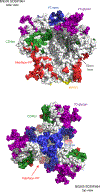Recent progress in broadly neutralizing antibodies to HIV
- PMID: 30333615
- PMCID: PMC6440471
- DOI: 10.1038/s41590-018-0235-7
Recent progress in broadly neutralizing antibodies to HIV
Erratum in
-
Publisher Correction: Recent progress in broadly neutralizing antibodies to HIV.Nat Immunol. 2019 Mar;20(3):374. doi: 10.1038/s41590-019-0329-x. Nat Immunol. 2019. PMID: 30705417
Abstract
In this Review, we highlight some recent developments in the discovery and application of broadly neutralizing antibodies (bnAbs) to human immunodeficiency virus (HIV); i.e., antibodies able to neutralize diverse isolates of HIV. We consider the characterization of novel bnAbs, recent data on the effects of bnAbs in vivo in humans and animal models, and the importance of both kinds of data for the application of Abs to prophylaxis and therapy and to guide vaccine design. We seek to place newly discovered bnAbs in the context of existing bnAbs, and we explore the various characteristics of the antibodies that are most desirable for different applications.
Conflict of interest statement
Competing interests
The authors declare no competing interests.
Figures




Comment in
-
New HIV prevention approaches: promise, praxis, and pitfalls.Lancet. 2022 Jul 23;400(10348):257-259. doi: 10.1016/S0140-6736(22)01351-4. Lancet. 2022. PMID: 35871803 No abstract available.
References
-
- Kwong PD & Mascola JR HIV-1 vaccines based on antibody identification, B cell ontogeny, and epitope structure. Immunity 48, 855–871 (2018). - PubMed
Publication types
MeSH terms
Substances
Grants and funding
LinkOut - more resources
Full Text Sources
Other Literature Sources
Medical

